All I could remember about Ios, from our honeymoon 27 years ago, was its reputation as a party island. We had already held an awesome party in the form of an outdoor wedding reception in the wine country of California’s Sonoma Valley. When we had finally shed ourselves from all the strings of post-weddingness and boarded the flight to Greece, late-night parties were not high on my list. I wanted to be a regular tourist, with regular tourist ambitions in Greece, like touring the Parthenon and relaxing on the sands of a sun-bleached island. Mykonos, like Ios, hadn’t made the honeymoon cut, but after Karen and I spent three days there earlier this summer and appreciated the island’s charms, I felt bad that we had stereotyped it into a corner. For sure, it was no fun being anchored off the cacophony that is Paradise Cove, but we found the old town of Mykonos immensely stroll-able and oozing with striking bougainvillea at every turn. Now, as we sailed Sea Rose into the main harbor at Ios, I tried to keep more of an open mind. If nothing else, we greatly appreciated the protection of the harbor, nearly enclosed except from the Southwest, making the high winds from the North less threatening. We had heard that the public dock was a good option here, in fact, the only option. With the high frequency of big passenger ferries arriving constantly, they needed all of the navigable water in the harbor to turn and maneuver on to the ferry landing. If anchoring in the harbor was forbidden because of this ferry traffic, I was completely accepting; neither of us wanted to get rolled by the ferry’s wake, or worse.
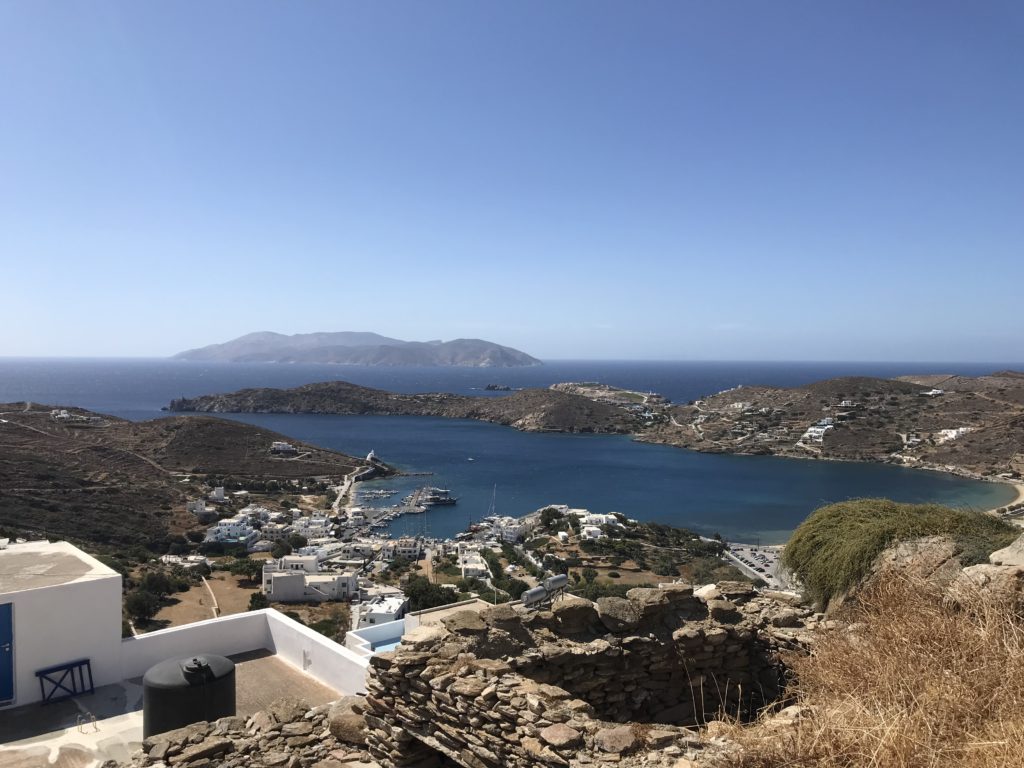
We nuzzled our way into an open slot at the town dock, carefully laying our anchor out plenty far so we would hold solid with the building winds. We placed our full fender inventory on both sides of the hull, staged the long stern lines specifically designed for med mooring, and dropped our dinghy in the water so we could float it off the bow, out of the way of the action at the stern. Karen, bless her soul, deftly backed Sea Rose in between the other sailboats on either side of us, with a careful balance of speed for maneuverability, but slow enough to stop before hitting the concrete pier. I don’t think my heart will ever find a resting pulse during these med moor situations. Each one seems to be slightly different, and as much as you think you know what you are doing, you are learning something new each time. I just don’t want the kind of learning that comes with a fiberglassing bill at the end of the season!
We had arrived at Ios to meet up with our friends Dan, Shelly and Don who would be arriving by ferry from Athens the day after tomorrow. Dan was given a hallway pass to come sans-wife, as Kathy was not a person whose physiology mixed well with the rolly life of the sea. This trio had first joined us last year along the Almafi coast. While the scenery there was out of this world, I did feel bad that we had been pinned down in the marina for three days to wait for a scirocco to blow itself out. I was intent on making their visit this summer a little more mobile.
It wouldn’t be without a high wind start though. Winds were forecasted to peak at 25 knots overnight, which normally wouldn’t be a problem in a harbor set inland from the coastline as this one was. Yet, the town dock was on the downwind edge of the harbor, giving the wind enough running room to build up white caps inside and slam into the concrete dock at our stern, ricochetting back to meet other oncoming waves, making it feel like we chose to dock within a washing machine. With our stern bouncing up and down just feet from the concrete, it was hard to settle the nerves and get some sleep. Our dinghy, left tied at the bow from our earlier med moor, was being yanked mercilessly on its short line, trying to break free or at least rub the gelcoat off our bow. We woke up in the middle of the night and, floating the dinghy back to the stern, raised it just off the water on the davits, an option for rough anchorages that we were only just now learning. It worked great, and provided a buffer between us and the dock. If our anchor dragged, we might damage or lose a dinghy but at least the big boat would be OK.
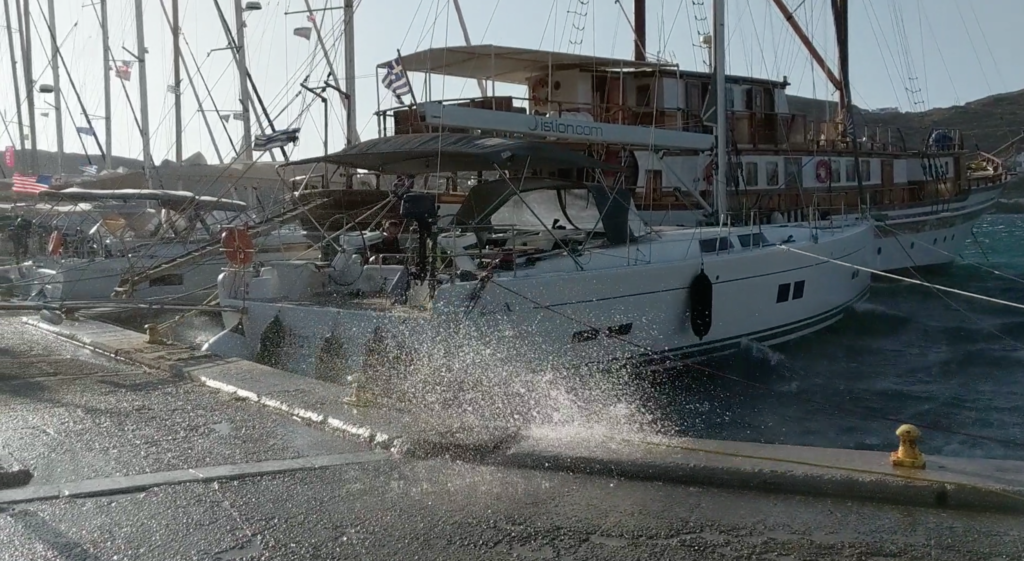
In the morning I woke up feeling as rested as a parent with a newborn baby, but with the arrival of our new guests, the day was bound to improve. We gathered around the ferry dock in the company of other islanders, as if we were part of the local hospitality service, welcoming hotel guests or car rental patrons. The majority of the crowd were those departing Ios, however, and this collection of people fell into two groups. Those amped up on what was clearly the end of a fantastic visit, lingering for a late morning coffee or early day beer at one of several dockside cafes. Or, those with a more subdued persona, reflecting on the realities of leaving the sun kissed islands of Greece before returning to home life.
But there’s only one type of arrival passenger – bubbly and brimming with anticipated fun. And the wide-brimmed smiles on Dan, Shelly, and Don’s faces were right in line. It was so good to see them again. One of the joy’s of traveling with friends is the discovery of new places with the comfort of the familiar.
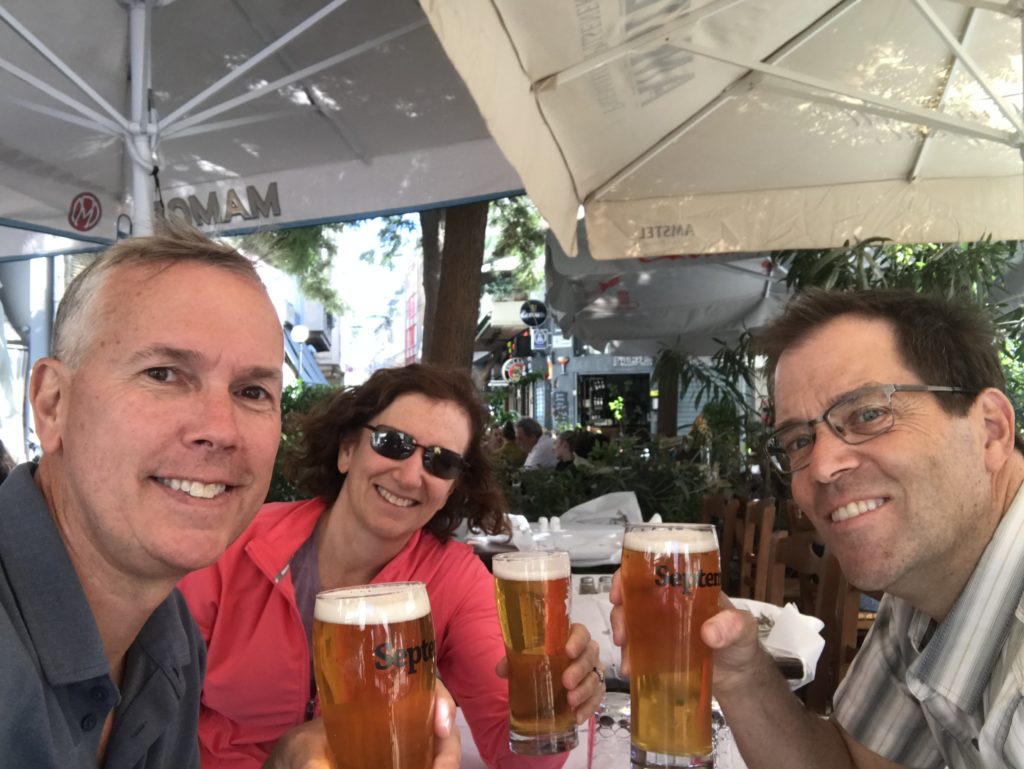
And discovery was about to begin. We started with a tour of the town of Ios, which centers around the Chora. Translated, chora (pronounced ‘oar-ah’) simply means ‘town’ in Greek, but often here where the island name is also the name used for the principal town, you will see the town referred to as Chora. As in other countries with a sea pirating past, Greek island main towns are often located way up in the hills and this was certainly the case with Ios. It was quite the hike to get to the top, but inside the narrow, windy streets and boutique cafes and storefronts, you could get a sense of how this town was party central in the height of summer. One of the highlights for us was the discovery of the ‘Shush’ silent disco bar, regrettably not open at this hour, but a great photo op for my shush-sensitive wife!
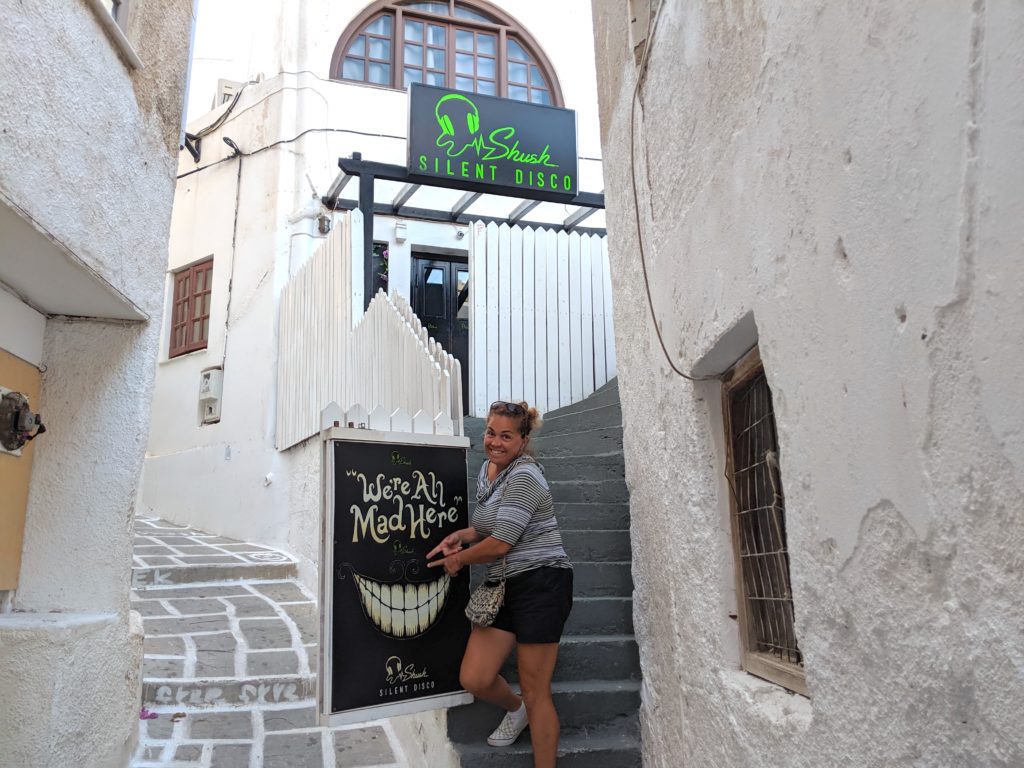
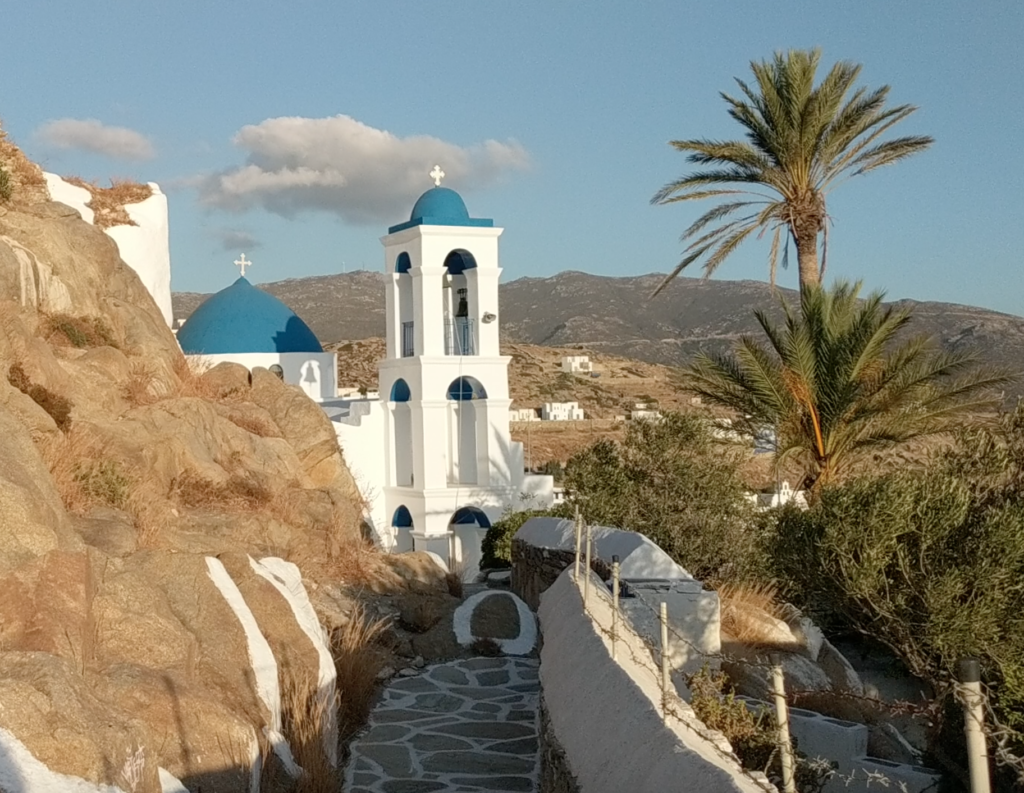
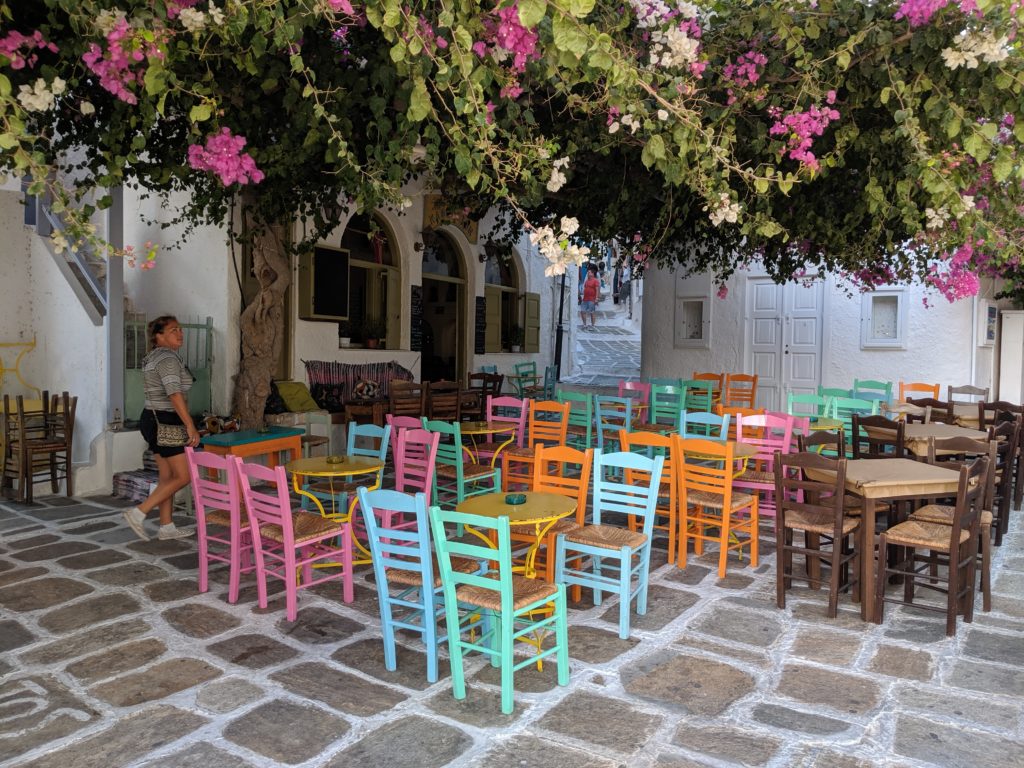
After our friends had a day of acclimation at Ios, it was time for some broader discoveries. The wind had died down to a few zephyrs, and our anchor came up without drama, despite the large goulet docked next to us with chain seeming to cross ours. We motored around the north side of iOS, with the island of Iraklia in our sights so that our guests could experience snorkeling over the WWII plane wreck. To learn more about that, read our previous blog post. This gave the wind enough time to rise to the occasion and soon after, we were sailing along in a gentle 15 knot breeze towards Amorgos. Hardly any boats accompanied us on this peaceful day, a sign that most of the European summer vacation crowd had returned home. It is good and bad to be sailing in the shoulder seasons. Clearly it is attractive for the lack of people and plentiful anchorage options. But there is a certain feeling of comfort when you are seeing amazing sites with a crowd of other gawkers. It reinforces the value of that which you behold. I’m reminded of this every time I go clothes shopping. While stopping at a display of shirts, pants or what have you, if others are milling about, quite often they will stop to look too. We are curious creations, attracted to the curiosity of others.
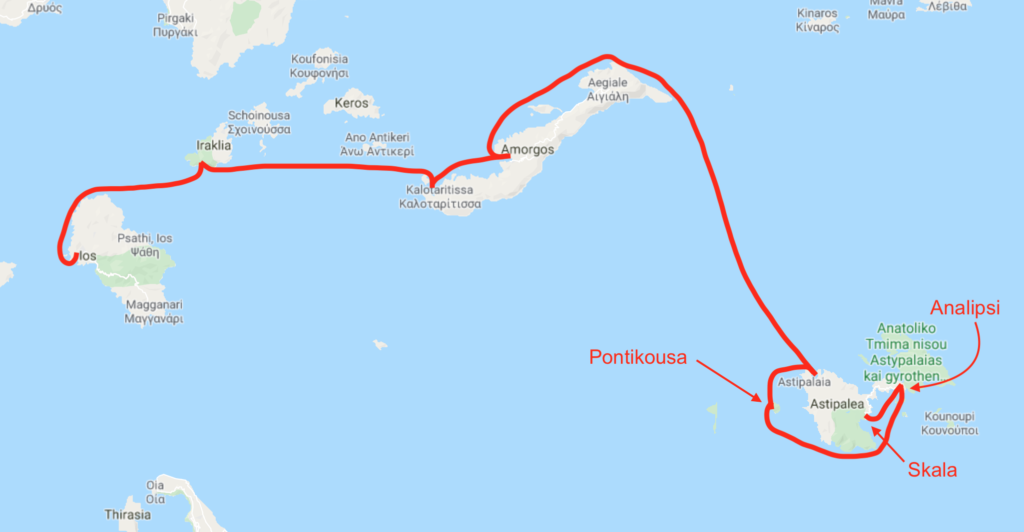
At the western tip of Amorgos is the small harbor of Kalotaritissa, a mouthful for sure, but with enough space for 2-3 visiting boats to anchor amongst the local fishing fleet. Amorgos is a long skinny island, requiring multiple days to really see and understand it, with this western outpost setting the first stage. Ashore, we hiked along a dusty road for an hour to descend into a steep ravine where the rusty hulk of the shipwreck ‘Olympia’ rested. In 1980, she had ran aground here after the captain unsuccessfully tried to seek shelter from a storm. It became fodder for the movie set of ‘The Big Blue’, and today it was the swimming playground for Dan, the only one of us willing to take the risk of being around sharp pointy objects above and below the surface.

On our return, a little refreshment was due and we found a micro-sized taverna at the beach. It wasn’t hard to distinguish the five of us in tourist frock versus the priest and two elder Greek women setting next to us. Sometimes you can only blend in so far with the locals!
Sadly, it was later that evening, while chatting in the cockpit after dinner, that we all learned of the passing of our dear friend Emmy, who had just been onboard earlier this summer in Croatia. Don and Shelly had seen her in the hospital recently, but her rapid health decline had prevented us from getting back home in time to see her and say our goodbyes. It was fitting, in our reflective mood, that we weren’t on a party island like Ios.
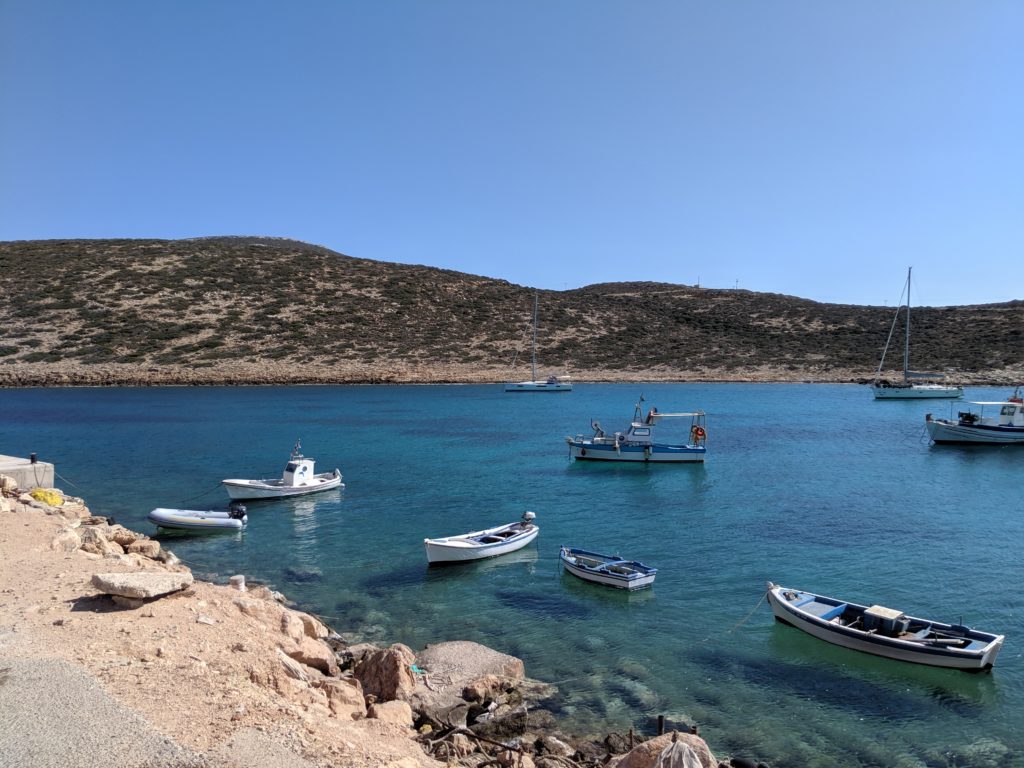
There are many interesting sights to see inland on Amorgos and it seemed like the best approach would be to rent a car at the main harbor of Katapola. Our reprieve from high winds was going to end tonight too, so getting into a better protected harbor was attractive. The scene upon our arrival was conducive to staying for a month; as we dropped our anchor and backed down to med moor to the town pier, a produce market, bar and many cafes beckoned us directly across the little waterfront street. Dan wittingly joked that we could just wave down the waiter and have our drink order delivered to the cockpit! This was the quintessential Greek sailing experience I had pictured from all the reading we had done – one becomes part of a small collection of sailboats parked with a front row view of small Greek island life. No towering Hilton hotels, few if any t-shirt shops, but plenty of earthy aromas and scintillating menu boards of simple Mediterranean fare. Somewhere in this harbor the ultra-sleek jet boats come to disgorge their ferry passengers, but the scene in front of us now was worlds away.
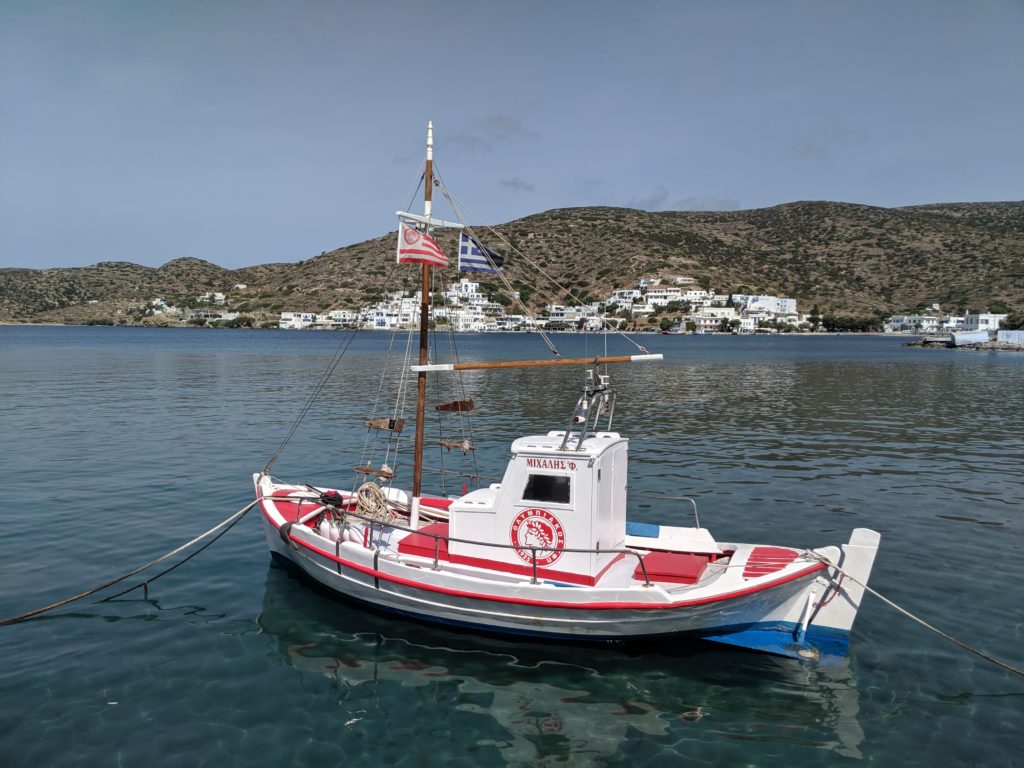
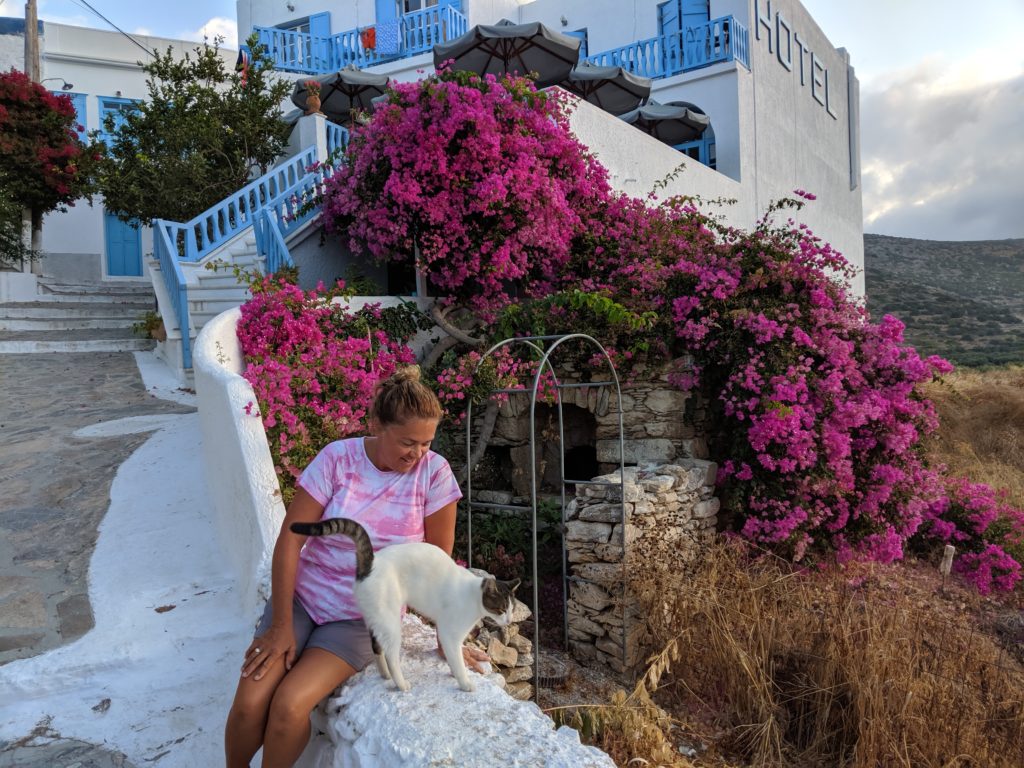
A few steps down the waterfront were four people at a single rental car agency eager to exchange 20 euros for a full day rental. We left it up to them to determine how to split the loot, but we zipped away, chuckling at how, only in Europe, would five adults cram into these four door mini sedans smaller than a VW Golf that are so ubiquitous in the rental car fleets. There were times I wasn’t sure we would have enough horses to climb the windy road to the Chora in the center of Amorgos, but once you get used to these little cars, they will start to grow on you. Miserly on gas, easy to park in the smallest of spots, and absent the slow acceleration and poor handling of a big SUV from back home.
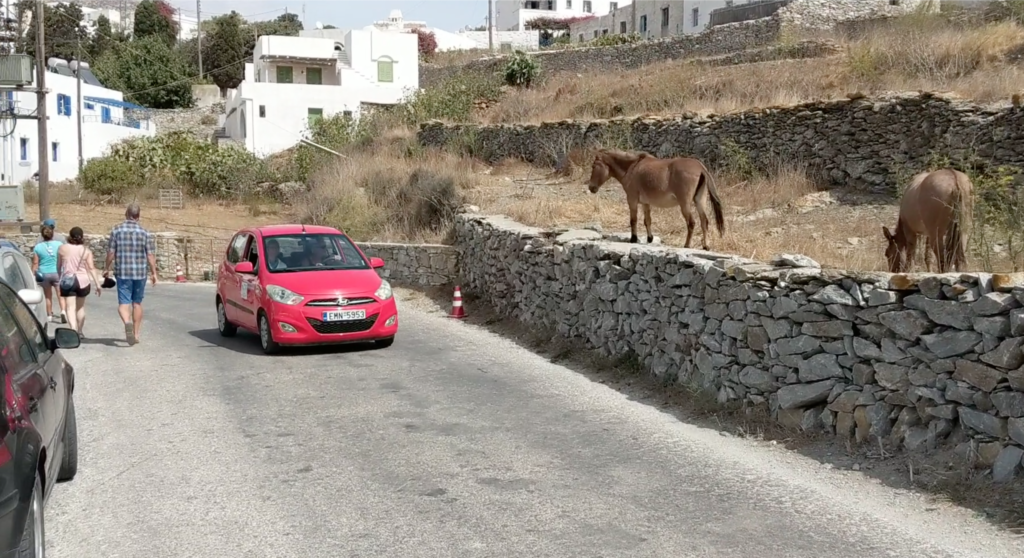
The Chora here in Amorgos was tucked into the saddle of one of the high ridges where, nearby, remnants of old windmills attested to the frequent high winds. As it was today, high dark clouds were moving in from across the sea, announcing the arrival of winds forecasted tonight.

We dropped over the ridge line to the southern coast, a long straight line as far as you could see in both directions, steep, with house-sized rocks deposited in the shallows below, land that could no longer hold on against gravity’s persistence. I was sure glad we had not tried to sail along this fearsome coast trying to find refuge for the night.
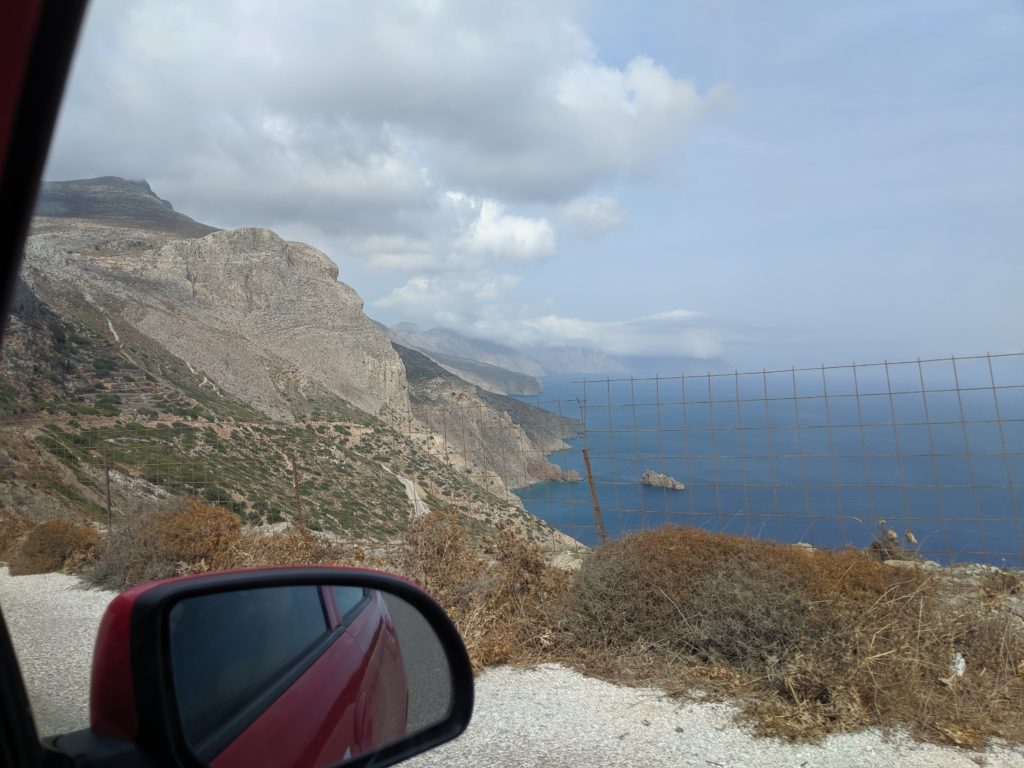
This was a scenic coast for sure, enjoyable from land or sea, but a coast of passage nonetheless. We descended along a narrow windy road that apparently the Greek government believed did not possess enough risk to warrant a guard rail. We had given the driver seat to Dan, partly because he was easily the tallest, but having never driven with him, I was feeling my heart race and my mind trying the practicality of jumping out the door before the car slipped over the side. Thankfully, all of this scenario planning was wasted energy, and we converged onto a tiny sand beach where we swam in the cool Mediterranean water in the company of a few other delighted tourists, who from their accents seemed to beckon from a wide range of nations, as it should on this treasure of an island, off the beaten track as it were from the Mykonos’ and Ios’ of the world.
A driving tour of Amorgos would not be complete without a visit to the monastery. This 11th century work of robust engineering is only 5 meters wide but many more meters tall, built literally into the cliff edge. Covered in bright white paint, we would later be able to ID it from 20 miles offshore, a single white speck standing out against an arid brown background. The parking area is minuscule, more encouragement to drive a tiny rental car. I fly the drone, knowing I have done this kind of scenic flight a hundred times, but still anxious to get it back in hand before I flew it – or a blustery wind took it – into the unforgiving cliff face and it tumbles out of view to the whitewater below.
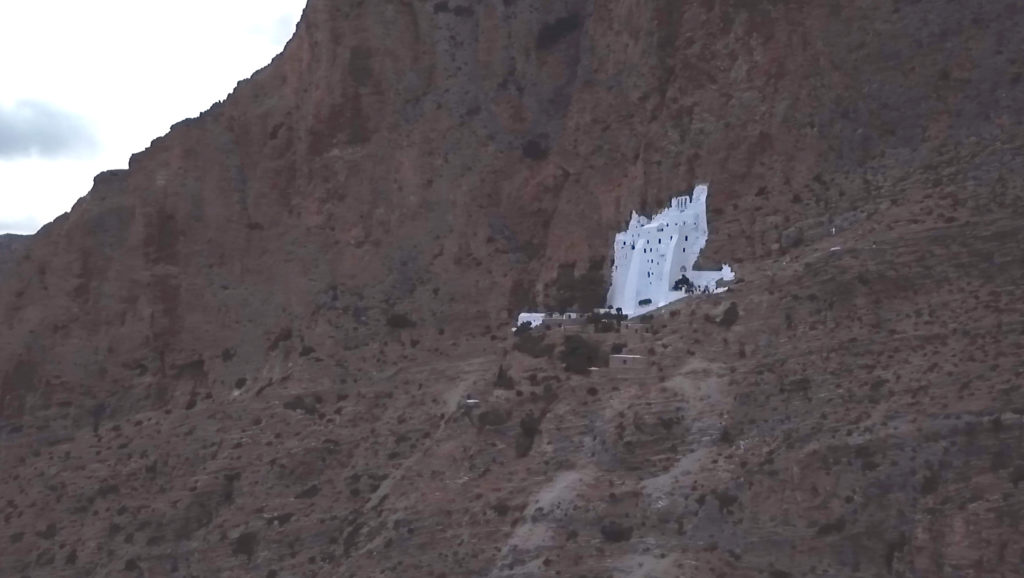
Up the long stone path, itself a marvel of engineering as it switchbacked up a loose collection of narrow ledges, and where those were absent, the hard-earned stone excavation by stronger men than I, we found ourselves in front of a friendly monk on a skinny veranda. Behind him was a rack of ramshackle clothes, with muted colors and frayed edges, items that even the Goodwill might pass over. But for the men in our group that chose to beat the heat in shorts, we were required to cover up with our choice of the many pairs of long pants. I am often the last to arrive at this junctures, as I am lingering to take pictures, the beauty of nature consuming my thoughts, so I had little time to select a pair of wool trousers and catch up to the rest of our group. As I was struggling to hold up what was a pair of pants clearly too many sizes too big, the waistline sliding down my thighs like a disgruntled teenager, I was slightly irked at the women who passed me, showing – almost flaunting – their bare shoulders and knees. How did they get a bye from the monastic dress code?! I felt a bit of a modesty role reversal, wondering how women must feel in strict Muslim dress.
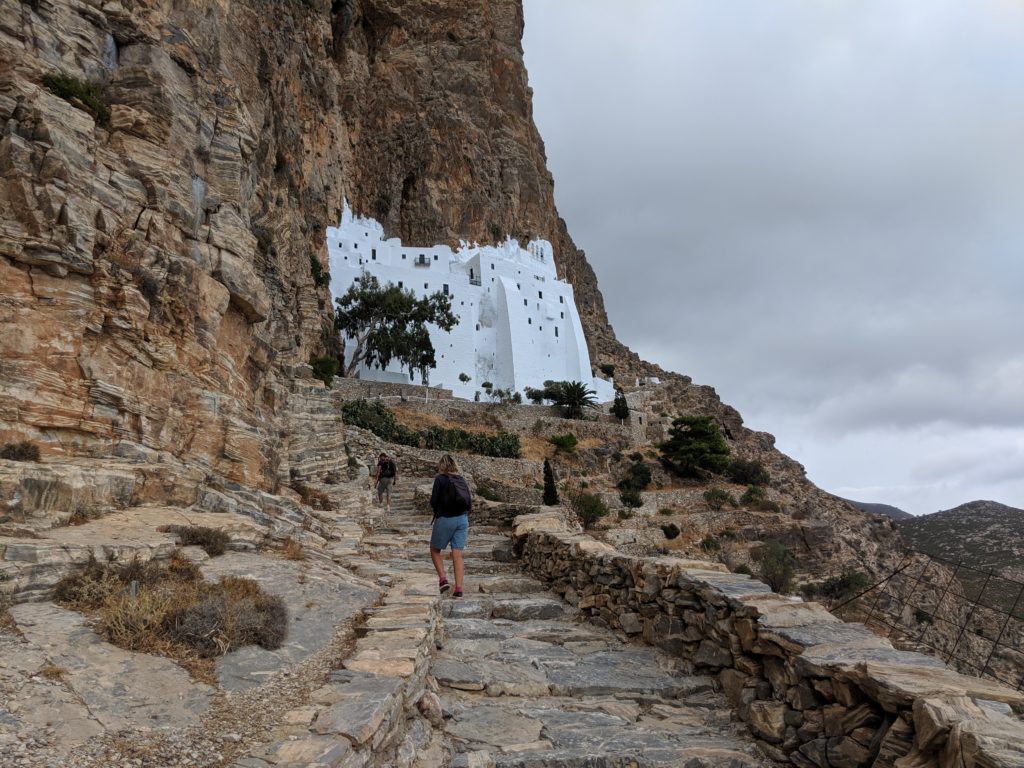
Inside we ascended stairs, at times too narrow for two to pass, to be greeted by more cordial monks and finally by what appeared to the abbot. One piece of artwork, which they proudly referenced as being over 500 years old, struck me as out of place in this windy, humid and dark environment. Surely an art historian could setup better atmospherics to preserve these works. A few extra euros went into the collection pail with that hope. Before heading back downstairs, we were offered a sweet liquor together with a refreshing glass of water and left to sit in awkward silence, around other awkwardly clothed visitors.
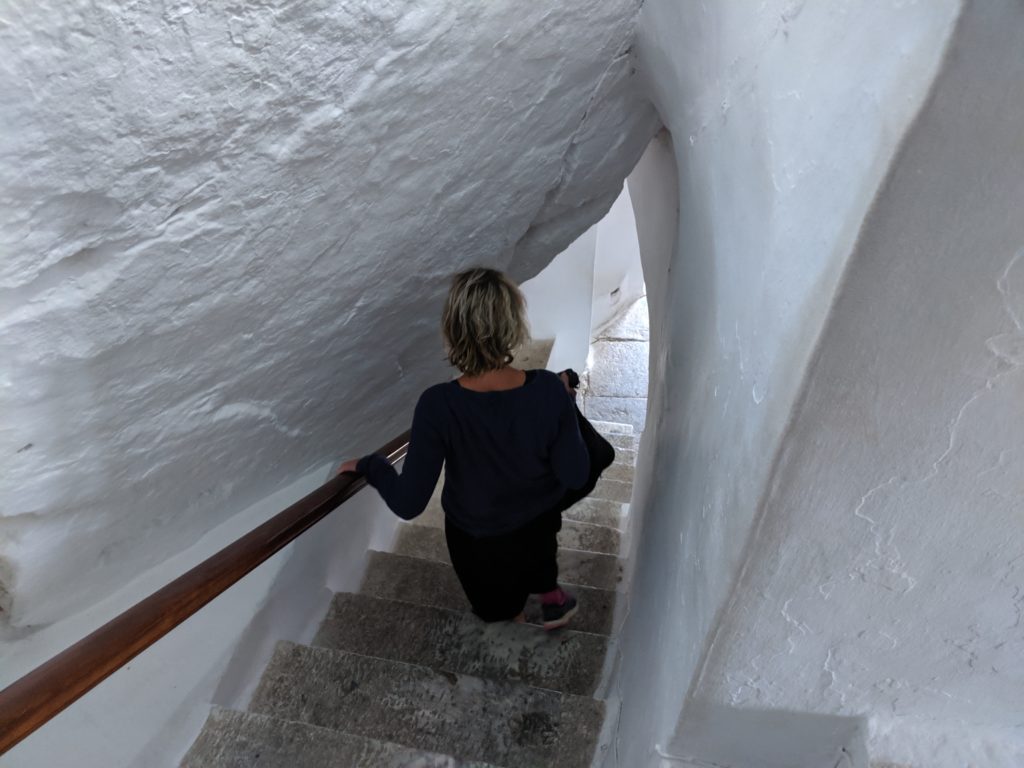
We continued by car to the very eastern end of Amorgos on the recommendation from the over-staffed car rental agency. Here in Langada, not to be missed, was a special goat dish called Potatato. We arrived after dark, with the first challenge simply finding an open taverna in post-high season Greece. To our dismay, this special dish is so special it is only served during a particular summer festival. Instead, we opted for what was labeled just ‘goat in the oven’. It came with potatoes, and if it wasn’t ‘special’ in the eyes of the locals, it was still pretty darn delicious on the palates of our group. I was thankful to have Dan behind the wheel on the long, dark and sleep-inducing drive back to the boat.
Having completed our end to end tour of Amorgos, it was time to move on. In the morning, we dropped our stern lines and motored forward to retrieve our anchor, pleased that it had not become a tangled mess with other boat’s anchors, like the fate a few of our neighbors were dealt. In light winds, we motored around the northeast tip of Amorgos, a slightly longer route to our next island of Astipalea than heading southwest, but with the prospects of more scenery. While it was dramatic to view, this choice proved unfavorable with the crew, as the rolling waves reflected off the hard rock of the coastline. Sailors can be a fussing lot, but in truth, too little wind means you are at the mercy of the waves, rolling and pitching your boat like the proverbial cork in the water, and too much wind is, well, just too much and uncomfortable. We couldn’t get around the northeast tip quick enough to escape the agitated seas and make our turn to the south for open water. Free of the chains of Amorgos, we had a delightful downwind sail for the remaining 30 miles to Astipalea, the island from which our guests would depart in a few days.
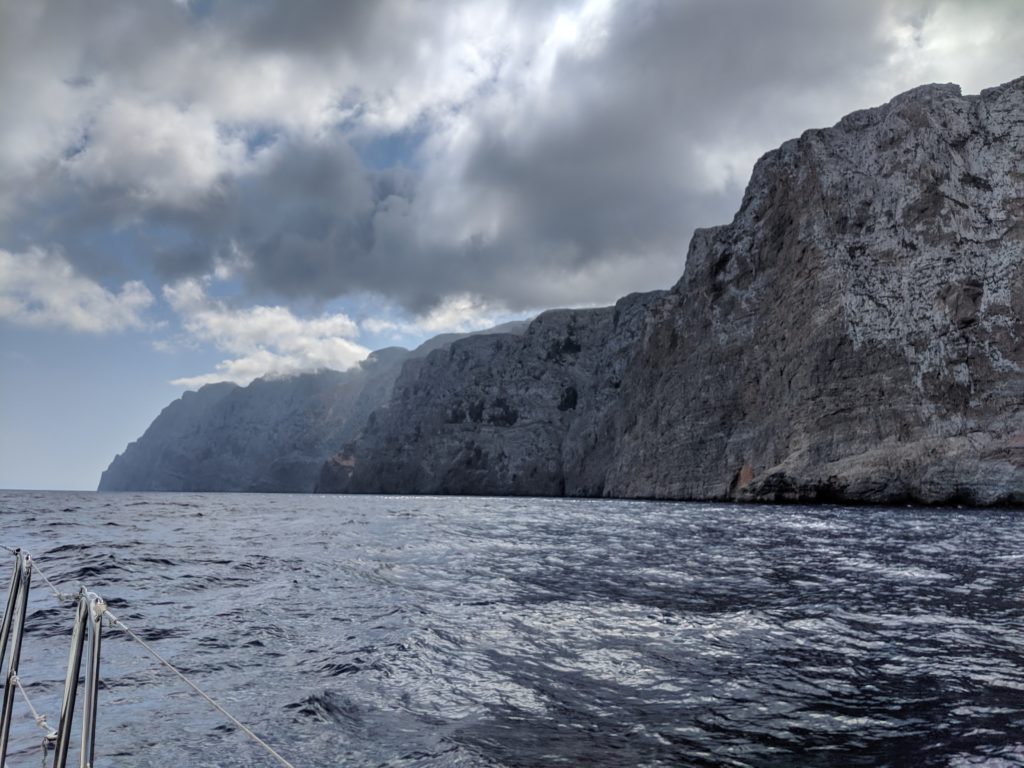

Arriving late in the day on the north shore, we found an isolated anchorage, so isolated you could be led to wonder if anyone had ever been here before, apart from a small white chapel in the valley distant. This notion was dispelled soon after, when we snorkeled around the cove and found a collection of spent artillery shells in the shallows. Darkness seemed to come quick, and with no discos to choose from, we accepted the perfectly reasonable substitute of staring into the inky black night trying to pick out satellites from the myriad of bright stars.
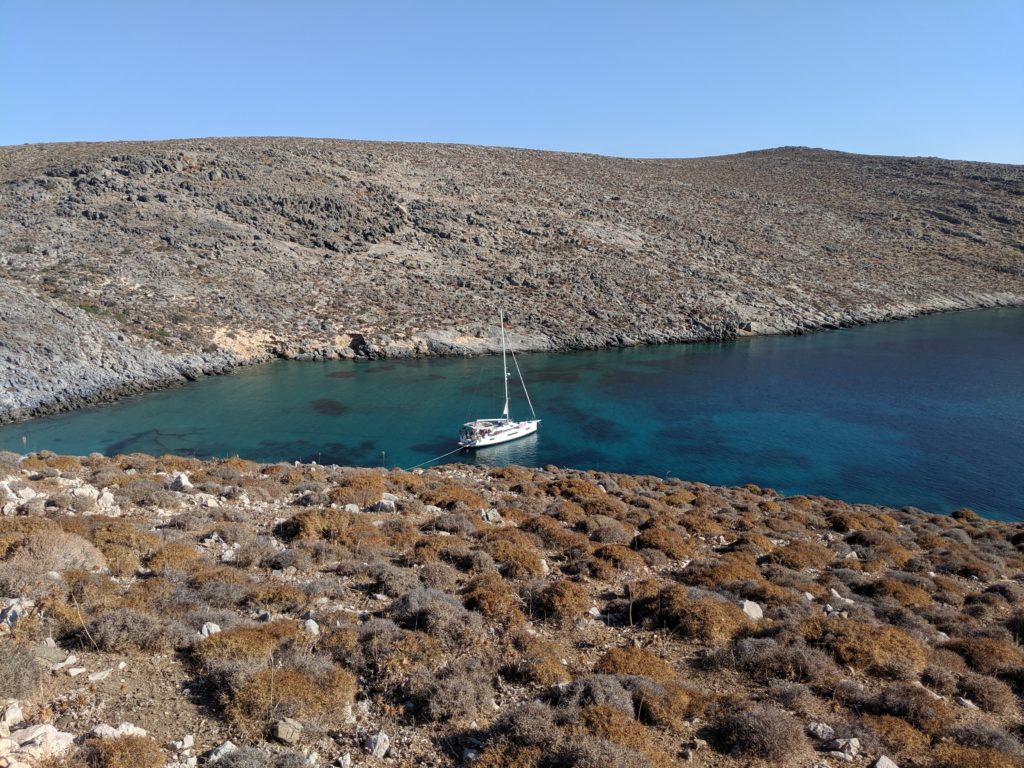
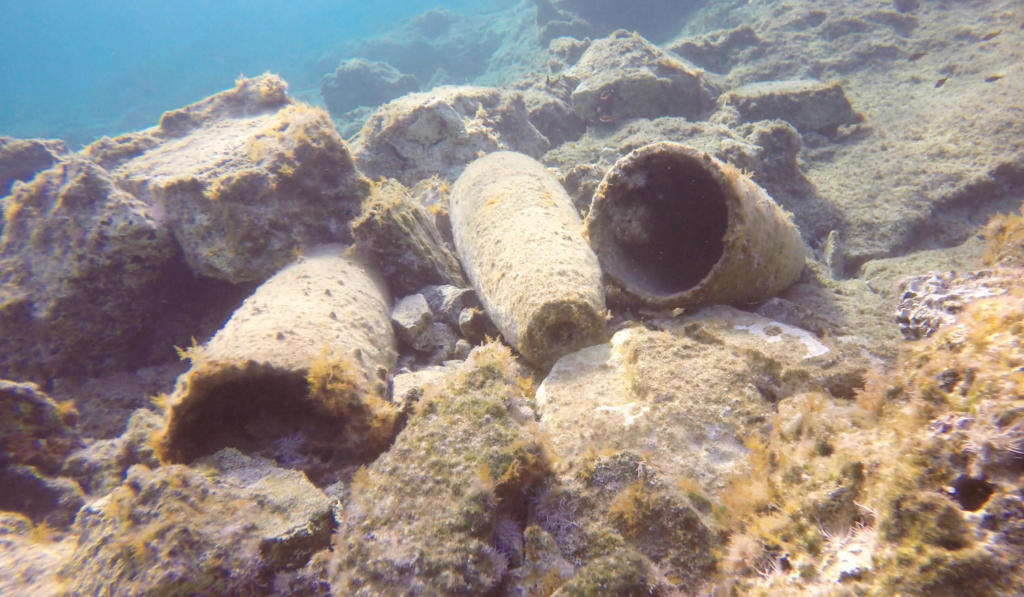
With the little white chapel beckoning us to learn about its details, we dinghied across the harbor in the morning and walked past startled sheep in what had to be one of the more low-maintenance ranches. A single dirt road wound its way down to the animal fencing, but no person nor vehicles appeared. The chapel had a simple latch meant to probably only keep the sheep out, and we poked inside to find an austere collection of candles and a few pictures of Jesus, signs of civilized life I suppose but leaving many more open-ended questions in this barren moonscape.

It was time to find more civilization, which we knew according to the cruising guide existed on the southern coast. We rounded the northwest corner and started heading south, with a slight diversion to a single lone island cut in the distinct Gibraltar-style shape, on a whim that there might be snorkeling nearby. Indeed, Pontikousa did have a little protected cove, deep and only suitable for a daytime stop, where all of us jumped in the water to cool off, with the only downside being a few stealth jellyfish leaving their translucent tentacles behind, stinging a few of us.
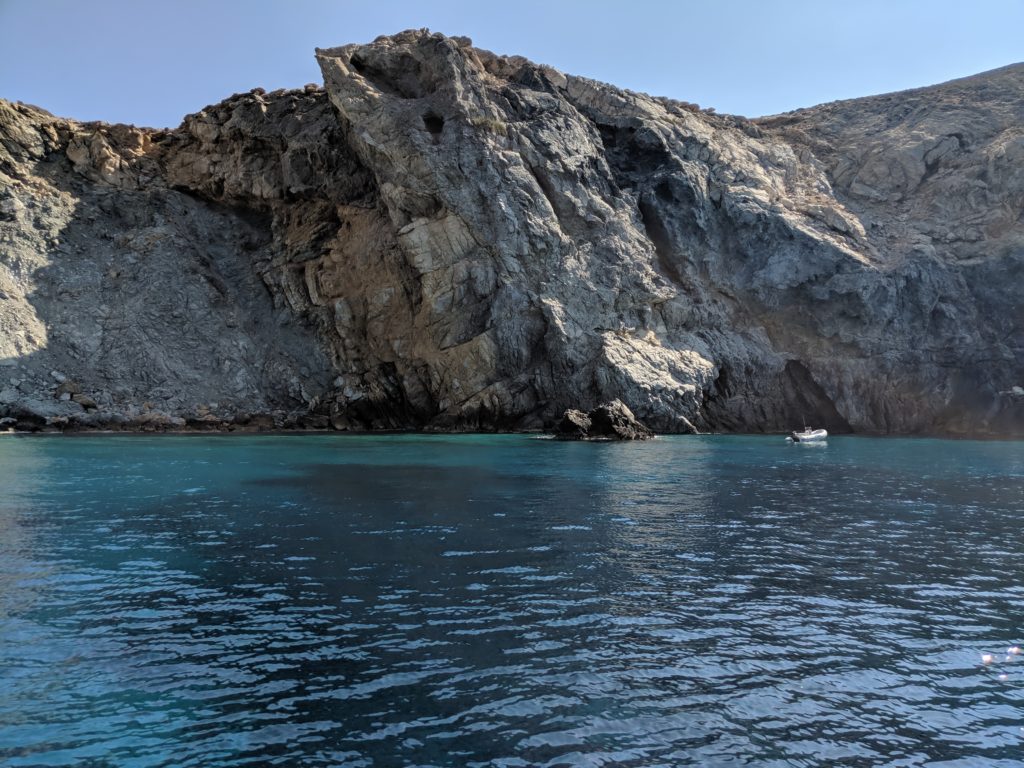
As we rounded the island and traversed the south coast, a light breeze gave us a chance to sail and, despite it dying out, Sea Rose made a peaceful 1.5-2 knot speed and no one seemed to mind the slow pace, with our destination close in the foreground. Having arrived where Dan, Shelly and Don would fly out, we were now under no pressure to make any additional long sailing legs, so we decided to check out the little town of Analipsi. There was a large round anchorage area that was a tempting option but we also found a single long concrete pier coming out from the beach holding several fishing boats, but with room for more. A fisherman onboard one boat beckoned us to use the end of the pier, and we happily side-tied Sea Rose to it. No sooner had we settled into our new home did another sailboat arrive, a young french couple, asking us if it was OK to tie to the pier. With our newfound experience and authority, we gave them an enthusiastic yes, and helped them with their lines.
Walking through the village revealed that we had missed the boat. All of the vacation rentals were closed up and we couldn’t find an open grocery store despite help from the cruising guide and Google maps. We finally stumbled on one street that had a few open businesses, one of which was a micro-sized cafe with just two tables out front, one taken over by either the owner or a close relative. We had beers and wine and were only set back 12 euros. Dan made up for it with a generous tip.
In the morning, we awoke to a lone Greek fisherman next to us in a boat that seemed custom fit for just him, hand lining with the patience of Job, apparently oblivious to the fact a bunch of tourists on Sea Rose were burning through SD cards trying to get the perfect water reflected image.
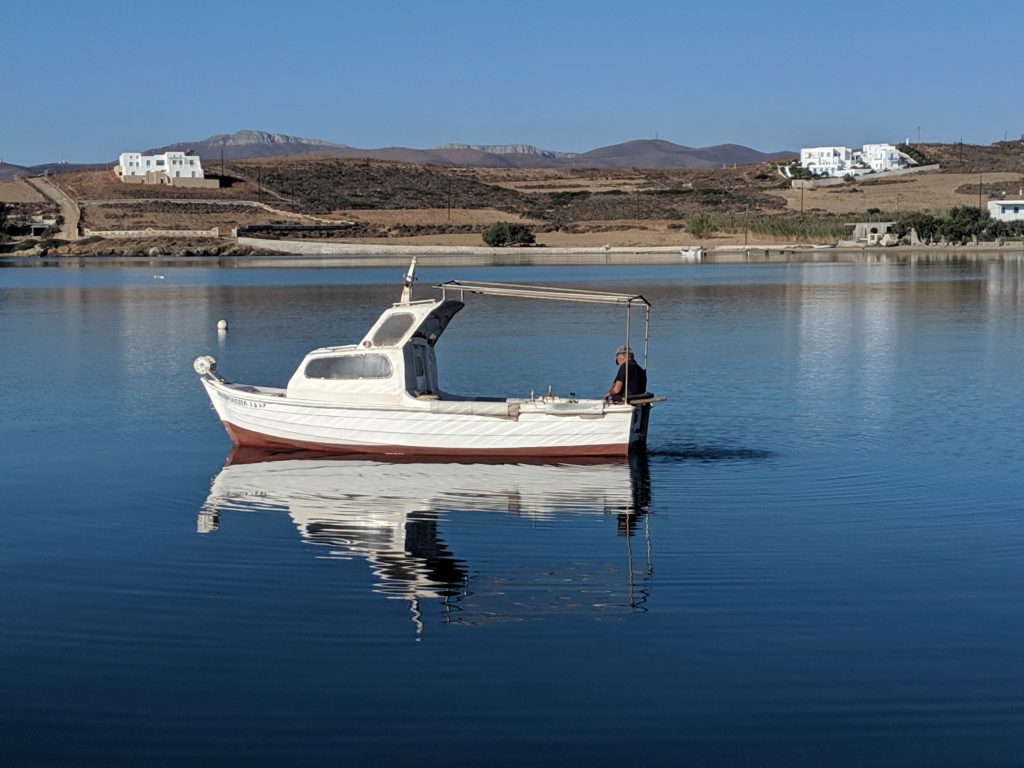
We dropped lines from this sleepy village and headed over to Scala, the main port with its prominent fortification on top of the harbor’s headland. After tying up to the town dock, it wasn’t hard to find more signs of life. We hiked to the top of the hill to figure out what the castle fortification was all about. It had suffered much damage from an earthquake in 1956, and the unstable stone walls pointed to years of weathering. The town had a city center high above the harbor, in a saddle between the headland and the mainland. Here, a classic Mykonos-style scene developed, with a collection of eight old windmills freshly painted, one of which housed the visitor center. The setting was so enduring, we returned later in the evening for a dinner surrounding mostly by locals, with their children playing a pickup game of soccer in the street.
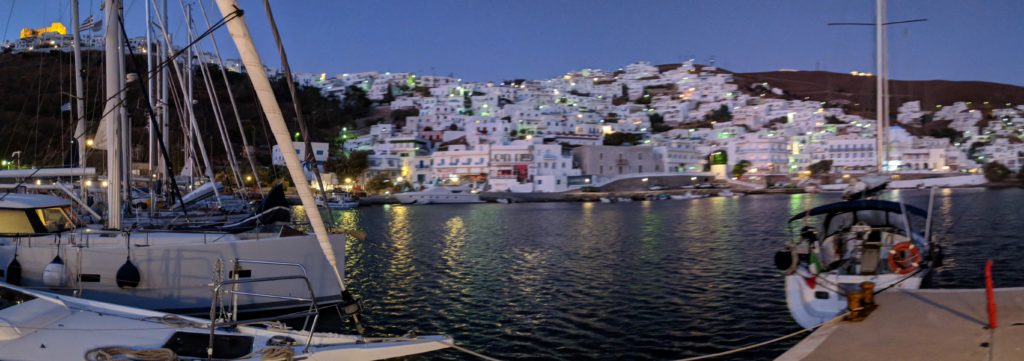

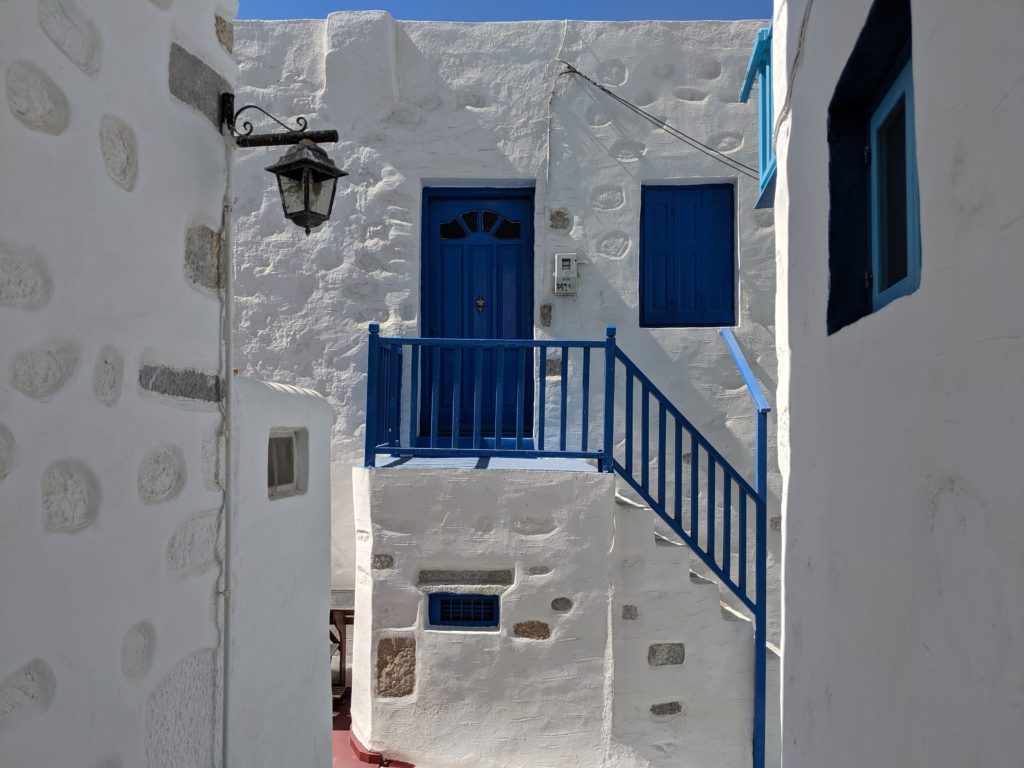
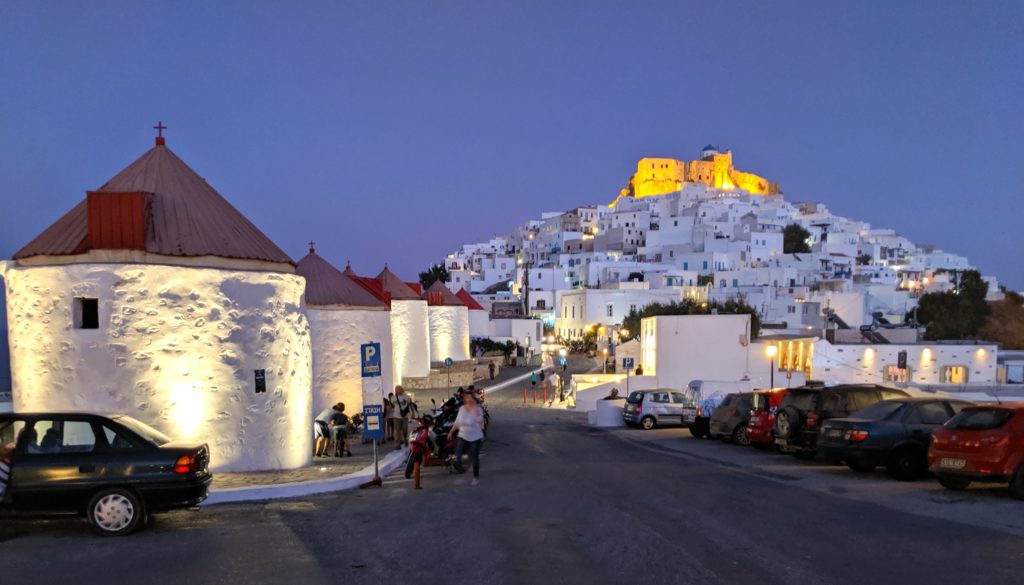
The following morning, we say our goodbyes to Dan, Shelly and Don as they catch what seems like the only taxi on the island, to the small airport with only two flights a week to Athens. It’s not a flight you want to miss! We had taken a chance on this little island off the main circuit as their departure point, and the arrival point of our next guests, Connor and Andree. In the end, the logistics worked without a hitch. Dan was nice enough to even take our damaged Code 0 sail home in our largest duffle bag, a bag ready to break at every seam! Thank you again Dan! And thank you also to Don and Shelly for coming to share in this off-the-beaten track adventure of the southern Aegean islands. It was fantastic to have you all on board for another summer adventure together!

